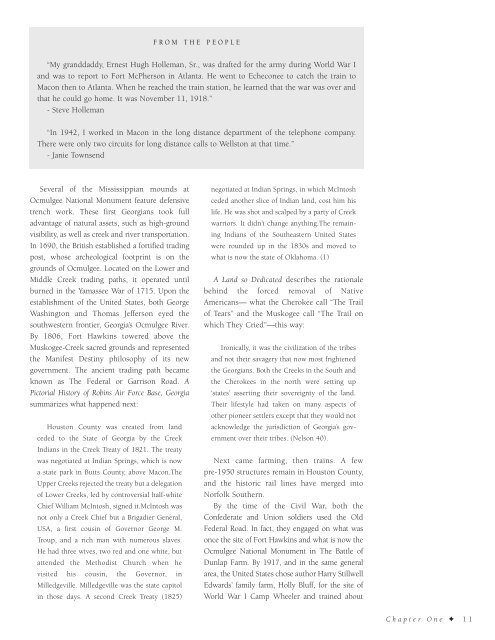Planes, Trains & Heroes: A Story of Warner Robins and the Robins Region
An illustrated history of Warner Robins, Georgia, paired with histories of the companies and organizations that have made the city great.
An illustrated history of Warner Robins, Georgia, paired with histories of the companies and organizations that have made the city great.
- No tags were found...
You also want an ePaper? Increase the reach of your titles
YUMPU automatically turns print PDFs into web optimized ePapers that Google loves.
FROM THE PEOPLE<br />
“My gr<strong>and</strong>daddy, Ernest Hugh Holleman, Sr., was drafted for <strong>the</strong> army during World War I<br />
<strong>and</strong> was to report to Fort McPherson in Atlanta. He went to Echeconee to catch <strong>the</strong> train to<br />
Macon <strong>the</strong>n to Atlanta. When he reached <strong>the</strong> train station, he learned that <strong>the</strong> war was over <strong>and</strong><br />
that he could go home. It was November 11, 1918.”<br />
- Steve Holleman<br />
“In 1942, I worked in Macon in <strong>the</strong> long distance department <strong>of</strong> <strong>the</strong> telephone company.<br />
There were only two circuits for long distance calls to Wellston at that time.”<br />
- Janie Townsend<br />
Several <strong>of</strong> <strong>the</strong> Mississippian mounds at<br />
Ocmulgee National Monument feature defensive<br />
trench work. These first Georgians took full<br />
advantage <strong>of</strong> natural assets, such as high-ground<br />
visibility, as well as creek <strong>and</strong> river transportation.<br />
In 1690, <strong>the</strong> British established a fortified trading<br />
post, whose archeological footprint is on <strong>the</strong><br />
grounds <strong>of</strong> Ocmulgee. Located on <strong>the</strong> Lower <strong>and</strong><br />
Middle Creek trading paths, it operated until<br />
burned in <strong>the</strong> Yamassee War <strong>of</strong> 1715. Upon <strong>the</strong><br />
establishment <strong>of</strong> <strong>the</strong> United States, both George<br />
Washington <strong>and</strong> Thomas Jefferson eyed <strong>the</strong><br />
southwestern frontier, Georgia’s Ocmulgee River.<br />
By 1806, Fort Hawkins towered above <strong>the</strong><br />
Muskogee-Creek sacred grounds <strong>and</strong> represented<br />
<strong>the</strong> Manifest Destiny philosophy <strong>of</strong> its new<br />
government. The ancient trading path became<br />
known as The Federal or Garrison Road. A<br />
Pictorial History <strong>of</strong> <strong>Robins</strong> Air Force Base, Georgia<br />
summarizes what happened next:<br />
Houston County was created from l<strong>and</strong><br />
ceded to <strong>the</strong> State <strong>of</strong> Georgia by <strong>the</strong> Creek<br />
Indians in <strong>the</strong> Creek Treaty <strong>of</strong> 1821. The treaty<br />
was negotiated at Indian Springs, which is now<br />
a state park in Butts County, above Macon.The<br />
Upper Creeks rejected <strong>the</strong> treaty but a delegation<br />
<strong>of</strong> Lower Creeks, led by controversial half-white<br />
Chief William McIntosh, signed it.McIntosh was<br />
not only a Creek Chief but a Brigadier General,<br />
USA, a first cousin <strong>of</strong> Governor George M.<br />
Troup, <strong>and</strong> a rich man with numerous slaves.<br />
He had three wives, two red <strong>and</strong> one white, but<br />
attended <strong>the</strong> Methodist Church when he<br />
visited his cousin, <strong>the</strong> Governor, in<br />
Milledgeville. Milledgeville was <strong>the</strong> state capitol<br />
in those days. A second Creek Treaty (1825)<br />
negotiated at Indian Springs, in which McIntosh<br />
ceded ano<strong>the</strong>r slice <strong>of</strong> Indian l<strong>and</strong>, cost him his<br />
life. He was shot <strong>and</strong> scalped by a party <strong>of</strong> Creek<br />
warriors. It didn’t change anything.The remaining<br />
Indians <strong>of</strong> <strong>the</strong> Sou<strong>the</strong>astern United States<br />
were rounded up in <strong>the</strong> 1830s <strong>and</strong> moved to<br />
what is now <strong>the</strong> state <strong>of</strong> Oklahoma. (1)<br />
A L<strong>and</strong> so Dedicated describes <strong>the</strong> rationale<br />
behind <strong>the</strong> forced removal <strong>of</strong> Native<br />
Americans— what <strong>the</strong> Cherokee call “The Trail<br />
<strong>of</strong> Tears” <strong>and</strong> <strong>the</strong> Muskogee call “The Trail on<br />
which They Cried”—this way:<br />
Ironically, it was <strong>the</strong> civilization <strong>of</strong> <strong>the</strong> tribes<br />
<strong>and</strong> not <strong>the</strong>ir savagery that now most frightened<br />
<strong>the</strong> Georgians. Both <strong>the</strong> Creeks in <strong>the</strong> South <strong>and</strong><br />
<strong>the</strong> Cherokees in <strong>the</strong> north were setting up<br />
‘states’ asserting <strong>the</strong>ir sovereignty <strong>of</strong> <strong>the</strong> l<strong>and</strong>.<br />
Their lifestyle had taken on many aspects <strong>of</strong><br />
o<strong>the</strong>r pioneer settlers except that <strong>the</strong>y would not<br />
acknowledge <strong>the</strong> jurisdiction <strong>of</strong> Georgia’s government<br />
over <strong>the</strong>ir tribes. (Nelson 40).<br />
Next came farming, <strong>the</strong>n trains. A few<br />
pre-1950 structures remain in Houston County,<br />
<strong>and</strong> <strong>the</strong> historic rail lines have merged into<br />
Norfolk Sou<strong>the</strong>rn.<br />
By <strong>the</strong> time <strong>of</strong> <strong>the</strong> Civil War, both <strong>the</strong><br />
Confederate <strong>and</strong> Union soldiers used <strong>the</strong> Old<br />
Federal Road. In fact, <strong>the</strong>y engaged on what was<br />
once <strong>the</strong> site <strong>of</strong> Fort Hawkins <strong>and</strong> what is now <strong>the</strong><br />
Ocmulgee National Monument in The Battle <strong>of</strong><br />
Dunlap Farm. By 1917, <strong>and</strong> in <strong>the</strong> same general<br />
area, <strong>the</strong> United States chose author Harry Stillwell<br />
Edwards’ family farm, Holly Bluff, for <strong>the</strong> site <strong>of</strong><br />
World War I Camp Wheeler <strong>and</strong> trained about<br />
Chapter One ✦ 11















